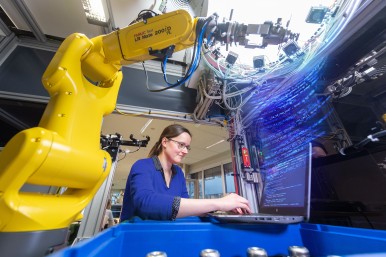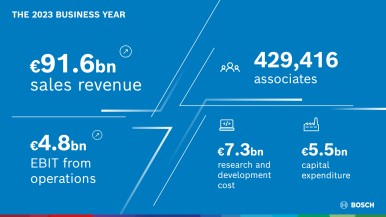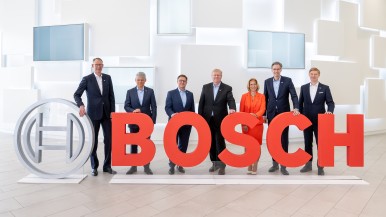Stuttgart and Hannover, Germany – According to the slogan “Factory of the future. Now. Next. Beyond”, the Bosch Group is presenting at Hannover Messe what the company already offers (now) for connected factories, what solutions will soon be available (next) and what it is developing for the future (beyond). Despite all connectivity and automation, humans and their creativity are indispensable in the Industry 4.0 era. Robots support them with complex and time-consuming tasks like data processing and quality control. This is also the message of 1.5 meter tall, Pixar-style 3D avatars. They take centre stage in Hannover and move around the virtual factory. All avatars are mock-ups of market-ready applications or pilot projects. Allow us to introduce them:
ActiveCockpit – the Data Collector
The intelligent communication platform ActiveCockpit from Bosch Rexroth visualizes data to make it easy to understand for everyone. Its gigantic screen informs employees about the production status by processing and visualizing production data in real time. As a result, manufacturing becomes more transparent, while faster information processing enables clear analyses and efficient procedures. Users and companies both benefit from the immediate identification of problems. This reduces downtimes and avoids potential recall costs; the quality level increases.
IoT Gateway – the Personal Trainer
Despite the Industry 4.0 hype, some companies have not yet arrived in the digital age. The machines lack sensors, software or the connection to enterprise IT systems – and hence important prerequisites for the connected factory. The Rexroth IoT Gateway can quickly and easily connect both old and new machines for Industry 4.0. The IoT Gateway unites sensors, software and IoT-compatible industrial controls, making it possible to detect the condition of machines. Even operators of older machines can reap the benefits of the connected industry without large investments.
APAS assistant – the Team Player
Humans are key players in the factory of the future: creative intelligence is in the employees’ minds. They are supported by digital devices and robots. The collaborative production assistant APAS assistant, for instance, supports employees with monotonous and ergonomically challenging tasks – without a safety fence. This human-robot collaboration is made possible by an intelligent safety concept. Thanks to its sensor skin, the APAS assistant recognizes its human colleagues without touching them and stops before a collision happens. Once the employee has left the immediate vicinity, the robot independently resumes its work exactly where it stopped before. This interaction of human and machine leads to higher efficiency, and sustainable optimization of the overall productivity, since employees can concentrate on more complex tasks.
ActiveShuttle – the Delivery Guy
Robots also support with internal transport processes. They drive through the factory and, for instance, transport material cases from storage to the production station. With the ActiveShuttle, Bosch Rexroth presents a concept for an intelligent, driverless transport system that automates the internal flow of material and goods. The integrated lifting platform automatically unloads goods in the logistics and manufacturing areas. Cyclical transport or a consumption-based material supply can also be realized with ActiveShuttle.
XDK – the Messenger
The universally programmable IoT multisensor XDK (Cross Domain Development Kit) is the “midwife“ for companies, who want to develop their own applications quickly and flexibly. In a compact box, the XDK combines a variety of MEMS sensors, for instance to measure acceleration, rotation angle, humidity, air pressure or temperature, with a powerful processor for the analysis, processing and transmission of the sensor data. Be it for predictive maintenance, monitoring or retrofitting: the XDK can be deployed universally; the programming language XDK Mita facilitates programming.
Apart from the avatars, Bosch is exhibiting the following highlights:
Foosball: learning by playing thanks to artificial intelligence
Table soccer has to be learned. To do so, we absorb and digest information with our senses, in this case the eyes. With the help of our brain, we learn systematically how to hold, play or pass the ball with the right force at the right time. Artificial intelligence (AI) works according to the same principle: instead of the brain, software processes the information with algorithms; cameras and sensors replace our senses. The soccer table, also called foosball or KI-cker (KI is the German abbreviation for artificial intelligence), teaches itself and optimizes its soccer abilities with every new co-player. Industrial applications such as robots or autonomous vehicles can also learn numerous tasks and optimize their performance thanks to AI. Their biggest advantage: even after the umpteenth try, they will not be frustrated.
Smart Cab for connected farming
Smart Cab, co-developed by Bosch as a member of the CAB concept cluster, turns agricultural vehicles into connected control centres in the field. All components – vehicles, cameras and drones alike – can interact with each other. Via the cloud, camera drones send detailed pictures of the condition of crops to the driver’s cab, and operators are warned by the object recognition camera about living obstacles such as deer. Vehicle users can download specific functions from a feature store over the air directly to the machines. Depending on the weather or soil conditions, for example, the nozzle settings can be adjusted.
Nexeed – new Industry 4.0 software for production and logistics
Connecting the entire value stream
Hardware applications need innovative software solutions running in the background to provide the necessary connectivity. At Hannover Messe, Bosch is presenting its Nexeed new software portfolio, which pools Bosch software and services for production and logistics. The Nexeed solutions make day-to-day work easier for employees and optimize production and logistics processes in terms of transparency, agility, cost, quality and time. The portfolio ranges from the sensor, over machine automation to the cloud. Nexeed solutions can be combined to connect individual lines, entire plants and plant networks, as well as their intralogistics and external goods flow.
Systematic production improvement
The Nexeed Production Performance Manager, for example, ensures systematic improvement of production by helping employees with decision making. For this purpose, the software collects and harmonizes production and machine data from many different sources and “translates” them into a common language. Subject-specific functions like the Ticket Manager, which was developed for the lighting company Osram, make it possible for the employees to complete their tasks faster and more purposeful. Using an app, employees are informed about the status of their more than 80 connected machines at all times. Upcoming tasks such as maintenance work or subsequent material deliveries are displayed, evaluated and assigned to the employee with the appropriate qualification.
Opening the data treasure chest with Data Analytics
The production process produces a large quantity of data of various types – the most important raw material of Industry 4.0. With Nexeed Data Analytics, this data can be used intelligently to identify new optimization potential. Customers do not have to deal with Data Analytics themselves; this task is entirely up to the Bosch experts. They gain important insights from product, process and machine data, which can be used to achieve improvements regarding quality, cost and delivery performance. Customers receive an individual service from the first data analysis to comprehensive prediction models.
Intralogistics en route to the digital age
Compared to modern production, the intralogistics sector is lagging behind regarding connectivity. Nexeed Intralogistics Execution deals with the three big challenges: keeping an eye on the vehicle fleet, optimizing material storage and designing transport routes dynamically. Information on all intralogistics processes are available in real-time. By unifying relevant data from different sources – for example RFID in the internal supermarket, forklift localisation and inventory information – the solution not only helps logistics specialist with the daily work, but also allows long-term planning.
Seamless transparency throughout the supply chain
These days frequent travellers can easily share information about their whereabouts. With Nexeed Track and Trace, Bosch has developed a logistics solution that enables the freight to record a digital travel diary. The software not only shares the current location, but also regularly sends information about temperature, vibration and humidity to the cloud via wireless sensors and gateways. This way, supply chains can be traced and permanently optimized. The international freight forwarding and logistics company Panalpina makes use of these benefits. They use Nexeed Track and Trace for a transparent supply chain – not only on the road, but also in the air. On the first test route between Germany and the recipient plant in the U.S, each package was equipped with a sensor. It records regularly relevant parameters such as vibrations. At each gateway, for instance when unloading the truck at the terminal or loading the airplane on the runway, data and the location of the time-sensitive goods are transmitted to the cloud. The Panalpina sees whether the goods have been loaded into the airplane and how they are doing.





